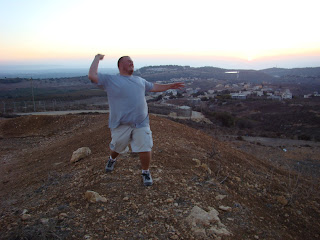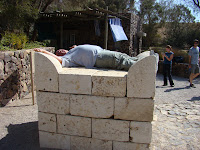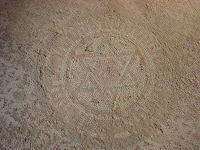
(looking at the sea through the breached walls)

(Fortification wall at Caesarea)

(more of the wall. During high tide this would have become a moat. The block at the end to hold the water has been torn down)
We then headed north again up to Haifa, Acre, the Ladder of Tyre at the Lebanon border. We then drove along the border road to the Jordan River. Acre and the Ladder of Tyre were spectacular. Seeing the fortress at Acre that was left from the Crusades and walking through the great halls and fortifications that were built almost a 1000 years ago. This city was the last foothold that the crusaders held in the Holy Land. This is were the Templars and other Military Orders held the hope of reclaiming the land for Christians. Walking the walls that are built right down into the sea and watching the water break against foundation built long before the Crusaders ever set foot in the Holy Land and they are still there holding back the water with little sign of wear.

(walls of Acre)
It made me reflect on what the Bible talks about building our faith on a solid foundation that can not be shaken. These fortification that have stood the test of time, weather and sea for thousands of years and still stand strong against the waves of destruction pounding them daily is the type of foundation I see that as being.
The Ladder of Tyre was not exactly what I had pictured, but it was a very beautiful place.

(Ladder of Tyre)
The stone of the cliffs was really white and spectacular in the fading light of evening. As the sun began to set out over the sea you could see the small patrol ships of the Israeli Navy moving back and forth across the border watching diligently the northern boundary. We stood at the gates of the upper military guard station holding the road leading into Lebanon and you could feel the tension of an active watchfulness with tight attention watching the enemy beyond. Israel and Lebanon are still officially at war and you could see and feel the signs of that as the soldiers in towers watched the moves of every one who lingered close to the border gates on either side.

(standing at the entrance to the Israeli Base Guarding the Border)
We got a closer look at the border as we headed east along the fences of the border. The road came close enough to the border that we could see that the two fences came within 30ft of each other. Feeling rebellious the three of us felt the need to show our support of those defending the border and cast stone into enemy territory.

(casting stones northward)
As we moved of the border near the Jordan River we headed back south to the Sea of Galilee where we stayed the night in a hostel on the cliff looking out over the sea. We got up early and headed out for the Syrian border. It was amazing to us as we drove because last week when we came up as a class we looked down on this valley from a mountain to the west and saw a road and an abandoned village just east of it. The road was Israel, the village was Syria. Now we were able to drive along the road we had seen and take pictures of the buildings in the village that was abandoned.
After tempting fate and the Syrian border we arrived at the Castle of Nimrod, which was a Muslim stronghold built during the times of the crusades. It was held and construction was done by both crusaders and Muslims, and this is evident in the architecture and styling of the different building eras. Even though the place is named now after the biblical character of Nimrod the great hunter that is a recent naming.

(The keep of Nimrod)
We spent almost 5 hours climbing all over Nimrod before we made the decent out of the northern mountains down to Baniass near Caesarea-Philippi. We decided to head down to the falls that are part of the head waters of the Jordan river that we missed during our class excursion. It is amazing to see the headwaters and think of how dry the rest of the country is in comparison. These falls and rushing rapid that they flow into are such a contrast that it is easy to forget less than 20 miles from here there is open dry desert. The idea of an Oasis is very prevalent throughout the whole country and the importance of them. It is hard to picture an Oasis when you are standing in the green fields of Nebraska, but here it is clear.

(The Baniass fall close to Caesarea-Philippi)

(just thought I would throw this one in for effect of where we were)
More picture albums for you too look at:
Galilee 1
Galilee 2
Galilee 3





































